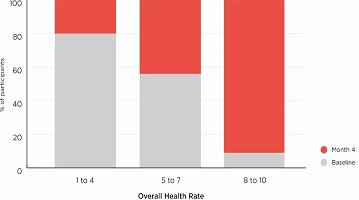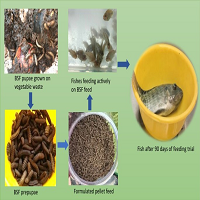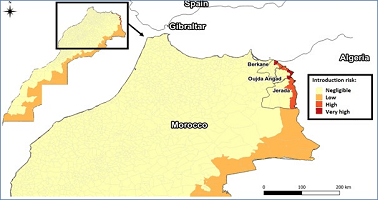Prostate cancer is the commonest cancer in USA and most European Countries and is the 2nd commonest cancer among males globally. An estimated 1.1 million men worldwide were diagnosed with prostate cancer in 2012, accounting for 15% of the cancers diagnosed in men. Incidence of this disease varies more than 25-fold worldwide; the rates are highest in Australia/New Zealand and Northern America (ASR 111.6 and 97.2 per 100,000 respectively), and in Western and Northern Europe, because the practice of prostate specific antigen (PSA) testing and subsequent biopsy has become widespread in those regions.1
Low incidence rates (<20 per 100,000) have been reported in most of the developing countries including India (Figures 1a and 1b). However, incidence of this disease has shown increasing trends in some developing countries.2 A few developing countries such as Brazil, Ecuador, Costa Ricain South America, the rates are almost similar to the rates in USA (Table 1).1 Among men residing in USA, Indians and Pakistanis have found to have increasing trend of Prostate cancer.3 Even though, the rates are less than 10 (per 100,000) in India, increasing trends have been reported in a few areas such as Delhi, Kolkatta, Pune, and Mumbai.4 In India, the highest rate has been observed in Trivandrum Taluk, South India (Figure 1b). In Trivandrum, it is the second common cancer among males and increasing trends in incidence has been observed (Figures 2a and 2b) (unpublished data).
Figure 1. Age adjusted incidence rates (AARs) of Prostate cancer in Developing countries & India.
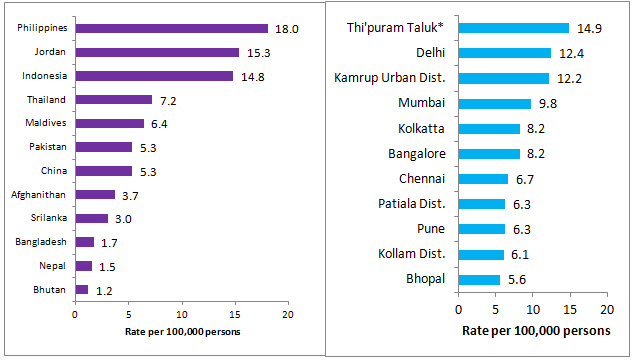
a. Developing countries (other than India) b. Indian registries
Table 1. Incidence rates (ASR) of prostate cancer in some developing countries (2003-2007).1
|
Developing Countries
|
2003
|
2004
|
2005
|
2006
|
2007
|
| Brazil |
112.6
|
159.4
|
177.4
|
186.7
|
157.1
|
| Colombia |
72.0
|
64.5
|
63.0
|
69.4
|
66.1
|
| Ecuador |
50.3
|
49.4
|
49.1
|
57.7
|
66.4
|
| Costa Rica |
57.5
|
55.1
|
52.1
|
51.5
|
53.2
|
| China |
12.0
|
14.0
|
13.8
|
14.4
|
15.5
|
| Thailand |
6.3
|
5.8
|
6.6
|
5.7
|
6.2
|
| Uganda |
35.4
|
41.1
|
34.8
|
54.3
|
43.8
|
Figure 2. Average annual new cases (#), crude (CR) and age-standardised incidence rates (ASRs) and age specific rates (ASpR) for prostate cancer, 2005-2014, TrivandrumTaluk.
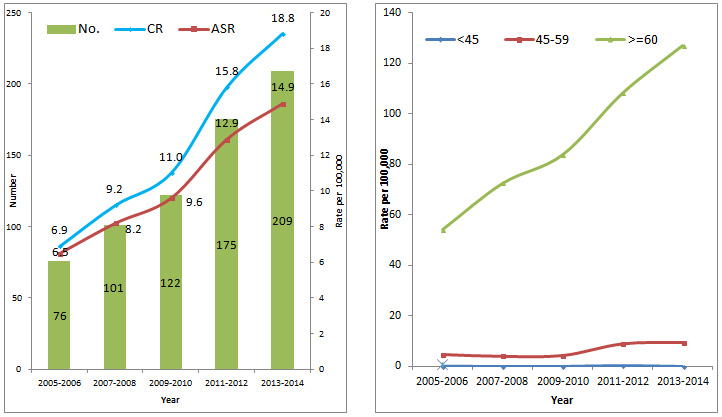
a. #, CR & ASR b. ASpR
Source: Personal communication
This indicated that an epidemiologic transition in prostate cancer pattern is taking place in developing countries and are changing to more similar to “western” jurisdictions. This change is worth studying as it is a quick transition. The well known risk factor for getting prostate cancer is age.5 There has been a steady increase in longevity of people living in this part of the country and this could partly explain the phenomenon. Also opportunistic screening by people belonging to higher economic strata leads to higher diagnosis. What would be more interesting is to learn about life-style changes particularly dietary changes occurring in developing countries as traditional food patterns could have been protective.
CONFLICTS OF INTEREST
The authors declare that they have no conflicts of interest.




